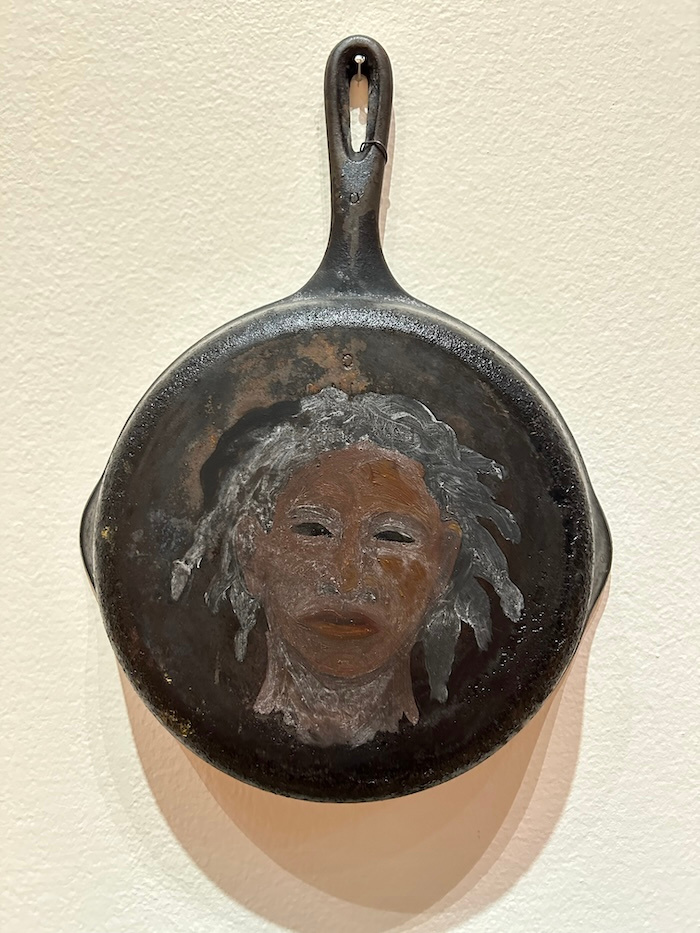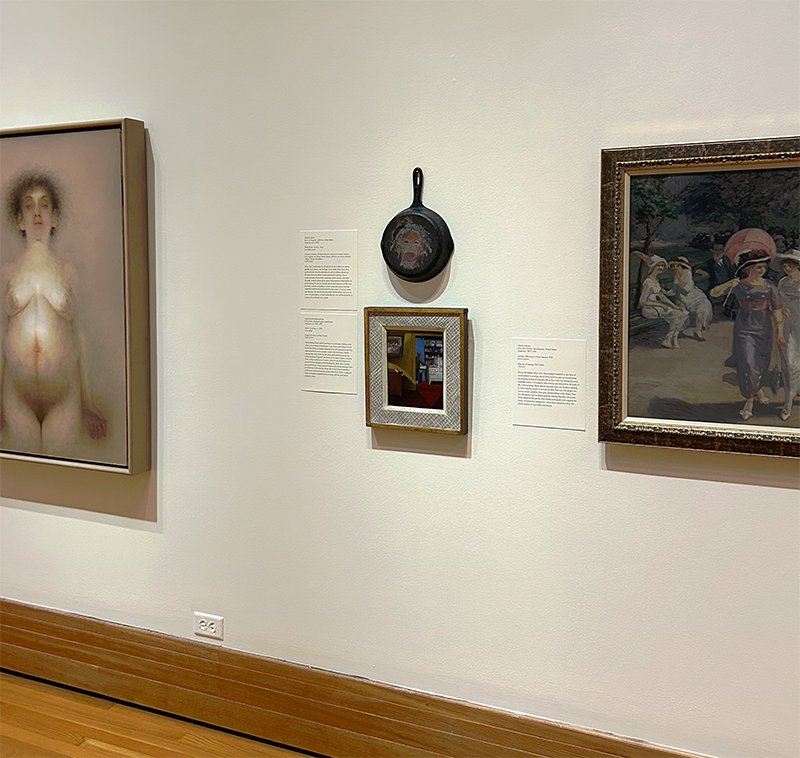Object of the Month: 'Skillet Study, “Eunice”' by Alison Saar
By Bowdoin College Museum of Art
Alison Saar, Skillet Study, "Eunice" (as installed in Currents: Art Since 1875), 2001, iron skillet, paint. Bowdoin College Museum, Brunswick, Maine. Archival Collection of Marion Boulton Stroud and Acadia Summer Arts Program, Mt. Desert Island, Maine. Gift from the Marion Boulton "Kippy" Stroud Foundation.
Created in 2001, Skillet Study, “Eunice” by Alison Saar represents a single work from a larger series of painted portraits on cast iron skillets. Like much of Saar’s work, the series seeks to honor the unseen labor and resilience of Black women throughout history.
Alison Saar was born in Los Angeles in 1956 to Betye Saar, an influential collage and assemblage artist of the Black Arts Movement, and Richard Saar, a painter and art conservator. Growing up in a family of creatives shaped Saar’s artistic development. Saar credits her parents with demonstrating the power of art as a means of storytelling, as well as with nurturing her respect for metaphysical and spiritual practices. Her work blends influences from African, Caribbean, and Latin American folk traditions while frequently incorporating found objects to evoke the layered histories of the African diaspora and the Black female experience.
In this series, Saar chose the skillet as her canvas to reference the contributions of Black women in the domestic sphere. This mundane object, commonly associated with domestic labor, symbolizes the work Black women have undertaken in kitchens and other areas of the home—first as enslaved individuals and then as domestic workers to predominantly white, upper-class families. Skillet Study, “Eunice” not only visualizes these racialized systems of labor but reclaims and revalorizes this history. Saar has said of the cast iron pan, “I love the dichotomy... It’s meant to nurture, to feed, to provide warmth, but it can also be violent, it can be used as a weapon.”1 In Saar’s hands, the skillet transforms from an instrument of labor into an expression of strength and resilience.
Saar has rendered a portrait of a woman named Eunice on the underside of the skillet. Her face appears faint against the cast iron surface, underscoring how contributions of figures like Eunice have been historically devalued and obscured. Further interrogating the issue of visibility, the figure’s dark and void eyes are a striking element of the work. Saar deliberately prevents the viewer from meeting Eunice’s eyes and creates a powerful gesture of resistance by not returning their gaze. Saar was inspired to create portraits with blank eyes after studying early depictions of enslaved individuals. She saw these figures working to preserve their dignity in the face of dehumanization and posed the question, “How do you survive those things and how do you survive those affronts?...One of the ways you do that is by not giving them the satisfaction of not [sic] returning that gaze.”2 In Skillet Study, “Eunice,” the absence of a direct gaze shifts the power dynamic, challenging viewers to confront their own role as both observer and participant in systems of oppression.
Saar’s approach to the gaze does not alienate viewers but instead draws them into a relationship with the figure of Eunice. Her dark, unyielding eyes compel us to look deeper—into her face, into history, and into ourselves. The form of the skillet even recalls a hand-held mirror, prompting viewers to read Eunice and themselves as reflections of one and other. Skillet Study, “Eunice” explores the intertwined histories of race, labor, and power while provoking a deeper reckoning with how these forces continue to shape our culture.
Currently on view in Currents: Art Since 1875, Saar’s work is a poignant reminder of the inner lives and undervalued contributions of those who shaped history from the margins.
